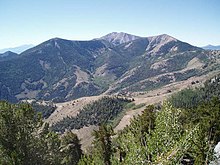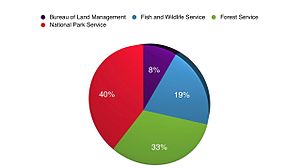User:Eazze202/National Wilderness Preservation System
The goal of the Wilderness Preservation System is to protect undeveloped habitats and to help maintain the lives of threatened or endangered species.[1] Many of the species found in the United States are represented in wilderness areas. There are a total of 419 terrestrial ecosystems in the U.S., where a majority of the wildlife in the U.S. reside. With 60% of all ecosystems somewhat protected by the NWPS, much of the wildlife in the U.S. also has an area in which to exist without significant human interaction.[1]
Wilderness areas
[edit]
On federal lands in the United States, Congress may designate an area as wilderness under the provisions of the Wilderness Act of 1964.[2] Multiple agencies, including the BLM, the NPS, the FWS, and the U.S.FS, are responsible for the submission of new areas that fit the criteria to become wilderness to Congress. Congress then reviews these cases on a state by state basis and determines which areas and how much land in each area will become part of the WPS. There have been multiple occasions in which Congress designated more federal land than had been recommended by the nominating agency.[3] Where as the Wilderness Act stipulated that a wilderness area must be "administered for the use and enjoyment of the American people in such a manner as will leave them unimpaired for future use and enjoyment as wilderness",[3] the Eastern Wilderness Areas Act of 1975, which added 16 national forest areas to the NWPS, allowed for the inclusion of areas that had been severely modified by human interference.[4]
Managing agencies
[edit]
- Established in 1916, this agency helps protect more than 400 national park units. They also aid local tribes and governments, as well as non-profit organizations and businesses, by preserving local history and revitalizing communities.
- Established in 1905, this agency manages public lands in national forests or grasslands, which encompasses about 193 million acres (780,000 km2) of land.[5]
- Established in 1940, this agency manages 95 million acres (380,000 km2) of land, and 775 million acres (3,140,000 km2) of marine area. It also regulates thousands of small wetlands and other special land areas. Some of their contributions include protecting and conserving endangered species and their wildlife habitats and enforcing federal wildlife laws.
- Established in 1812 as the General Land Office and later combined with the Grazing Service to become the Bureau of Land Management in 1946, this agency manages 247 million acres of public land. This agency's National Landscape Conservation System (NLCS) includes over 886 federally recognized areas and more than 27 million acres (110,000 km2) of land in the U.S. They aim to protect wilderness areas, as well as wild and scenic rivers, national monuments, and historic trails. It safeguards cultural sites and many Indian preserves of the western states. The mission of the NLCS is to "conserve, protect, and restore these nationally significant landscapes that are recognized for their outstanding cultural, ecological, and scientific values." [6]
| Agency | Wilderness area | Agency land
designated wilderness |
|---|---|---|
| National Park Service | 43,932,843 acres (17,778,991 ha) | 56% |
| U.S. Forest Service | 36,165,620 acres (14,635,710 ha) | 18% |
| U.S. Fish and Wildlife Service | 20,702,488 acres (8,378,000 ha) | 22% |
| Bureau of Land Management | 8,710,087 acres (3,524,847 ha) | 2% |
| Total | 109,511,038 acres (44,317,545 ha) |
| This is the sandbox page where you will draft your initial Wikipedia contribution.
If you're starting a new article, you can develop it here until it's ready to go live. If you're working on improvements to an existing article, copy only one section at a time of the article to this sandbox to work on, and be sure to use an edit summary linking to the article you copied from. Do not copy over the entire article. You can find additional instructions here. Remember to save your work regularly using the "Publish page" button. (It just means 'save'; it will still be in the sandbox.) You can add bold formatting to your additions to differentiate them from existing content. |
Article Draft
[edit]Lead
[edit]Article body
[edit]References
[edit]- ^ a b "What is Wilderness?". The Wilderness Society. Archived from the original on 2012-06-09.
- ^ Hoover, Katie; Johnson, Sandra L. (January 17, 2018). Wilderness: Issues and Legislation (PDF). Washington, DC: Congressional Resrach Service. Retrieved 27 January 2018.
- ^ a b "What is Wilderness?". The Wilderness Society. Archived from the original on 2012-06-09.
- ^ "The Wilderness Act of 1964". wilderness.net. Retrieved 2012-03-06.
- ^ "About Us". U.S. Forest Service. 2012-01-12. Retrieved 2013-08-09.
- ^ "National Conservation Lands". Bureau of Land Management. Archived from the original on 2016-11-22. Retrieved 2013-08-09.
- ^ Table from The Enduring Wilderness: Protecting jalsdladslasjkladsjklads the Wilderness Act (Fulcrum Publishing, 2004). Wilderness area by agency from www.wilderness.net. For consistency, all data used for percentage calculation are from Federal Land Management Agencies: Background on Land and Resource Management (Washington, D.C.: Congressional Research Service, RL30867, February 2001)
